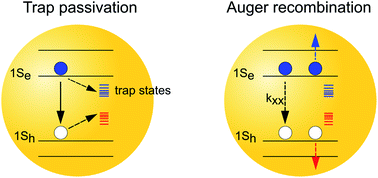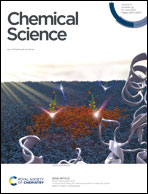Surface passivation extends single and biexciton lifetimes of InP quantum dots†
Abstract
Indium phosphide quantum dots (InP QDs) are nontoxic nanomaterials with potential applications in photocatalytic and optoelectronic fields. Post-synthetic treatments of InP QDs are known to be essential for improving their photoluminescence quantum efficiencies (PLQEs) and device performances, but the mechanisms remain poorly understood. Herein, by applying ultrafast transient absorption and photoluminescence spectroscopies, we systematically investigate the dynamics of photogenerated carriers in InP QDs and how they are affected by two common passivation methods: HF treatment and the growth of a heterostructure shell (ZnS in this study). The HF treatment is found to improve the PLQE up to 16–20% by removing an intrinsic fast hole trapping channel (τh,non = 3.4 ± 1 ns) in the untreated InP QDs while having little effect on the band-edge electron decay dynamics (τe = 26–32 ns). The growth of the ZnS shell, on the other hand, is shown to improve the PLQE up to 35–40% by passivating both electron and hole traps in InP QDs, resulting in both a long-lived band-edge electron (τe > 120 ns) and slower hole trapping lifetime (τh,non > 45 ns). Furthermore, both the untreated and the HF-treated InP QDs have short biexciton lifetimes (τxx ∼ 1.2 ± 0.2 ps). The growth of an ultra-thin ZnS shell (∼0.2 nm), on the other hand, can significantly extend the biexciton lifetime of InP QDs to 20 ± 2 ps, making it a passivation scheme that can improve both the single and multiple exciton lifetimes. Based on these results, we discuss the possible trap-assisted Auger processes in InP QDs, highlighting the particular importance of trap passivation for reducing the Auger recombination loss in InP QDs.



 Please wait while we load your content...
Please wait while we load your content...